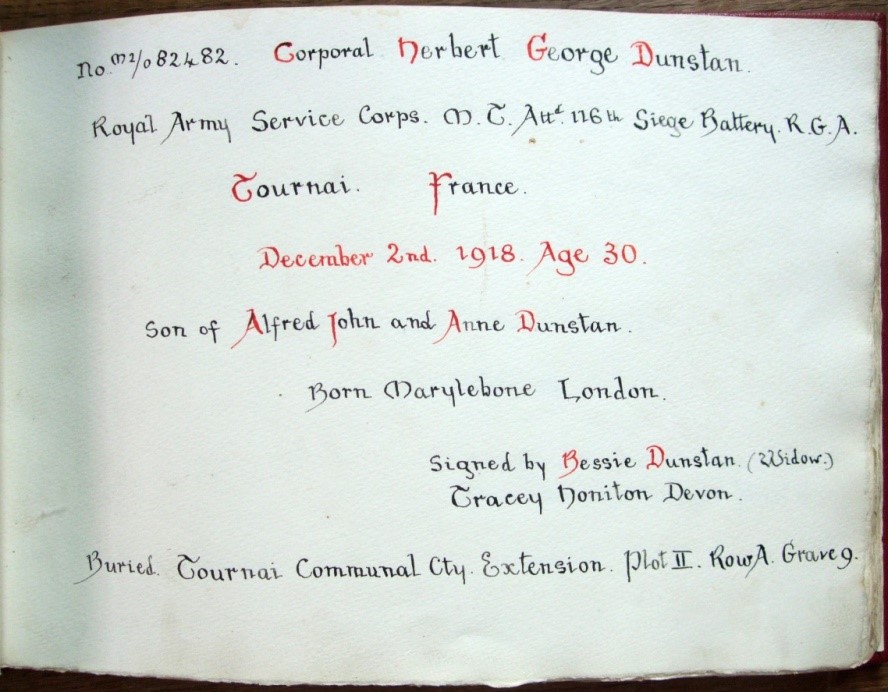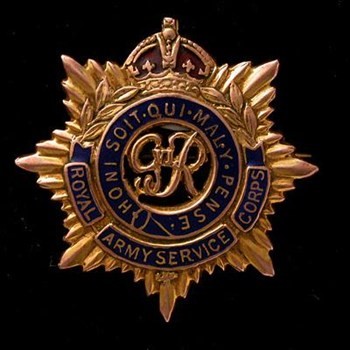HERBERT GEORGE DUNSTAN
Corporal, M2/084282, Royal Army Service Corps, Mechanical Transport CompanyAttached 116th Siege Battery, Royal Garrison Artillery
Died at Tournai, Hainaut, Belgium, 2 December 1918, aged 30
Buried in Tournai Communal Cemetery Extension, Tournai, Belgium
Plot II Row A Grave 9

Entry for Herbert George Dunstan
in Forest Row's Book of Remembrance
(Click to enlarge)
Herbert George Dunstan owes his place on the Forest Row memorial to his widow Bessie, but as she was from Honiton in Devon when she submitted his details, it is not immediately clear what his connection with Sussex was. He was born in St Marylebone, third son of Alfred John Dunstan, a wheelwright, and his wife Annie née Bland. Both parents were Londoners by birth, and seem to have lived there all their lives. There had been six other children, but all had died before 1911, leaving just Alfred junior, Arthur and Herbert in the household in 1901.
The 1891 census shows the family living in Seymour Buildings in St Marylebone, and that is the address given on the School Admission and Discharge Registers for Bell Street School in Westminster where Herbert was a pupil, being admitted in 1891, aged only three. The register notes his date of birth as 5 May 1888.
By 1911 Herbert had probably left home as the census finds him visiting the Beadell family at the William IV pub in Albury in Surrey. Alternatively, he may have been on holiday, visiting friends or relatives or working in the area. He gives his occupation as motor driver mechanic. Three years later, but before war broke out, he married Bessie Hansford at Honiton in Devon. Bessie had been born in Dunkeswell in Honiton, but was in service as a cook in what was clearly a sizeable household in Tracey Honiton in 1911.
Two newspaper items suggest that his work involved a fair amount of travel. The first, in the Brighton Gazette on 16 March 1907, depicts him and several other men as victims of attempted fraud by criminals who made a living offering bogus posts in exchange for a payment of 10/-. The Hampshire Chronicle and General Advertiser dated 19 September 1909, reporting for the court in Basingstoke, shows that he lived for a time in Essex:
Herbert George Dunstan, motor driver, of Colchester...was summoned for exceeding the speed limit at The Hatch cross-roads, where there is a danger signal, at 9 a.m. on Monday September 7th...the car [was timed]... and [police] ascertained the speed to be between 26 and 27 miles an hour...the driver was in the service of an army officer. There was a corporal with him, and they were returning from the Salisbury manoeuvres.
There is no record of when Herbert enlisted, but there were no children from the marriage, and Bessie received a war gratuity of £21, which suggests he joined up in September 1914. As the extract above shows, he presumably already had experience of working with army personnel. His effects, which included the gratuity, amounted to £28 12s. 10d. The Commonwealth War Graves Commission record places him in the XIX Corps Heavy Artillery at the end of his life, and gives Bessie's address as Wood Cottage Combe Raleigh, Devon. It also lists an inscription on his grave:
Until the day breaks
Bessie had given Tournai, France as Herbert's place of death, but Tournai is actually in Hainaut in Belgium, though close to the border. He had survived four years of war and the cessation of hostilities only to die, aged 30, of pneumonia three weeks after the armistice was signed.

Badge of the Royal Army Service Corps
(Click to enlarge)
The Royal Army Service Corps, in which Dunstan served, was responsible for supply and transport. It seems probably that, with his driving experience, Herbert was involved in the delivery of food, fuel and hospital supplies, along with ammunition, from railhead to front line. He may also have carried soldiers, tanks or bridging equipment. He would also have needed to maintain his own transport, something for which his experience as a mechanic made him ideally suited.
The 116th siege battery, to which Herbert was attached, was sent to France on 18 June 1916. A post on the Great War forum suggests that the XIX Corps Heavy Artillery was at Amiens in April 1918, and as Dunstan died at Tournai, it seems that he may well have experienced a variety of areas on the Western Front. To date, though, no explanation has been found for his appearance on the Forest Row memorial. Maybe his wife was in service at one of the big houses there while her husband was away, and only returned to her native Devon after his death.
Pam Griffiths
21 August 2018
Updated 25 November 2019

